Your SAT Math score can give you an idea of how ready you are for college math courses. It can also help you to decide if you need to brush up on math some concepts to take the test again.
So, what do you need to know about your SAT Math score? Your SAT Math scaled score depends on your raw score. Your raw score is just the total number of correct questions (1 point each). The scale varies by test, but usually you must answer every question correctly to get a perfect scaled score (800/800). The average SAT Math score in 2021 was 528.
Of course, each question on the SAT Math section is worth the same (1 point) if answered correctly, so you should try to answer as many as you can to improve your score.
In this article, we’ll look at some key statistics for SAT Math scores, including the average test score, various percentiles, grade level, and more.
Let’s dive into the numbers.
Quick Summary Of SAT Math Score Statistics (2021)
The average SAT Math score for all students in 2021 was 528, with a standard deviation of 120. Assuming a normal distribution, this means:
- about 68% of students scored between 410 and 650 (within about 1 standard deviation of the mean)
- about 95% of students scored between 290 and 770 (within about 2 standard deviations of the mean).
The 700+ club is fairly exclusive: only 10% of students taking the SAT Math section in 2021 scored 700 or above.
Still, an SAT Math score of 600 or above put you in the top 27% of test takers in 2021.
If you scored 500 to 590 on the SAT Math section in 2021, you are in good company: 31% of students (almost a third) scored in that range.
The following bar graph shows a summary of score ranges for students taking the SAT Math section in 2021.
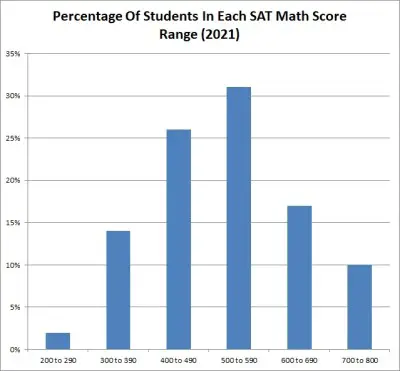
The students with the highest average SAT Math scores reported the following 5 intended majors:
- Mathematics & Statistics (mean score of 661, or 133 points above average – more than 1 standard deviation above the mean)
- Physical Sciences (mean score of 617, or 89 points above average)
- Computer and Information Sciences and Support Services (mean score of 600, or 72 points above average)
- Multi/Interdisciplinary Studies (mean score of 597, or 69 points above average)
- Engineering (mean score of 595, or 67 points above average)
It seems that students who are strong in math are attracted to these majors.
| Intended College Major | Mean SAT Math Score | How Far Over Mean |
|---|---|---|
| Mathematics & Statistics | 661 | 133 |
| Physical Sciences | 617 | 89 |
| Computer and Information Sciences and Support Services | 600 | 72 |
| Multi/ Interdisciplinary Studies | 597 | 69 |
| Engineering | 595 | 67 |
Finally, it seems that aiming high with your goals really does make a difference. The higher the degree level goal, the higher the average SAT Math score:
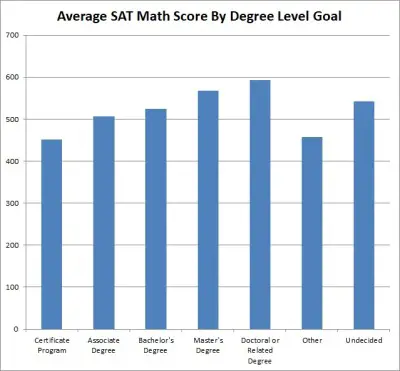
A Brief Note About College SAT Requirements
There may be some good news for those taking the SAT: there seems to be less competition these days. According to the College Board, the number of students taking the SAT in 2021 was down by 32% from 2020 (1.5 million students in 2021 vs. 2.2 million students in 2020).
This is largely due to two factors:
- The ongoing pandemic – many testing locations canceled or delayed SAT test dates in 2021. Even if test centers were open, some students felt unsafe taking the test in-person. In addition, some students changed their college plans to take a gap year or pursue a career without a degree (at least for now).
- College test requirements – many colleges have gone test optional over the years, and many more followed suit (or temporarily waived SAT requirements) in the wake of the events of 2020. (As of March 2022, MIT has reinstated their SAT requirement for students applying).
SAT Math Scores (What You Need To Know)
SAT Math scaled scores are calculated from raw scores, which comes from the total number of questions you answer correctly (more on this later).
Now let’s answer some common questions about SAT Math scores.
What Is The Highest SAT Math Score Possible? (2021)
The highest SAT Math score possible is 800 out of 800 (this corresponds to a raw score of 58 points). In most cases, you must answer every single question (all 58 of them) correctly to get a perfect score on the math section (sometimes, you can get one wrong or leave one blank – but don’t count on it!)
That means no questions left blank and no incorrect answers. You need to know the content and the test well enough to be able to answer every question correctly.
This is quite a feat – even for strong math students on their best day!
The lowest SAT Math score possible is 200 out of 800.
What Is The Average SAT Math Score? (2021)
The average SAT Math Score in 2021 for all test takers was 528 out of 800, with a standard deviation of 120 (as reported by the College Board).
Interestingly, students who took the essay portion of the test scored 15 points higher (an average of 543) on the math section than the entire test-taking group.
Also, students who took the SAT on a weekend scored 90 points higher in math (583 on average) than students who took the SAT during a school day (493 on average).
It seems that the more education a student’s parents have, the higher the student’s SAT Math score, as the following table shows:
| Parental Education | SAT Math Score |
|---|---|
| No High School Diploma | 458 |
| High School Diploma | 485 |
| Associate Degree | 504 |
| Bachelor’s Degree | 559 |
| Graduate Degree | 600 |
| No Response | 442 |
education can impact a
student’s SAT scores.
There is a very clear difference in the table: students whose parents have a Bachelor’s degree or higher score well above the average (528) on the SAT Math section. The same data is presented below in a bar graph:
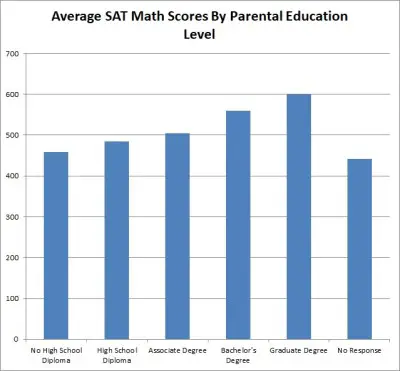
can impact a student’s SAT scores.
SAT Math Percentiles
Based on 2021 data from the College Board:
- An SAT Math Score of 800 puts you in the 99th percentile (top 1% of all test takers).
- An SAT Math Score of 700 puts you in the 90th percentile (top 10% of all test takers).
- An SAT Math score of 600 puts you in the 73rd percentile (top 27% of all test takers).
- An SAT Math score of 500 puts you in the 42nd percentile (top 58% of all test takers).
This PDF table (an Excel version of the table is available here) shows a sample breakdown of SAT Math percentiles by score range (from the College Board). [Note: the percentiles can vary from test to test and year to year; this is for illustration purposes only]
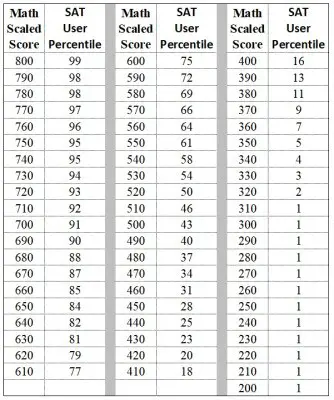
Remember that a percentile tells you the rank of an individual compared to the rest of the population. In other words, a percentile is a value that a percentage of the population falls below.
For example, based on the table, an SAT Math score of 740 puts you in the top 5% of test takers (95th percentile).
The 50th percentile (520) is the median, and this number tells us the value that separates the population into a top half (top 50%) and a bottom half (bottom 50%).
(You can learn more about percentiles and how to interpret them here).
Let’s look at some examples of how to convert between SAT Math scaled scores and percentiles.
Example 1: Finding Your SAT Math Percentile From Your Scaled Score
Let’s say that your SAT Math scaled score was a 620. Using the table above, we find that a scaled score of 620 corresponds to a percentile rank of 79.
So, an SAT Math score of 620 would put you in the top 21% of test takers (79th percentile) for that test.
Example 2: Finding An SAT Math Score From A Percentile
Let’s say that you want to score in the top 4% of test takers on the SAT Math to qualify for an engineering scholarship.
Based on the table above, we find that the top 4% (96th percentile) requires an SAT Math scaled score of 760.
You will probably only be able to miss or leave blank 3 questions on the entire math section if you want to achieve this score!
How To Calculate Your Math Score On The SAT (Conversion Of Raw SAT Math Score To Scaled SAT Math Score)
To calculate your score on an SAT Math practice test, you will need to take a few steps:
- 1. Check your answers against the answer key to see how many questions you got right, how many you got wrong, and how many you left blank.
- 2. Find your raw score, which is just the number of correct questions (1 point each).
- 3. Convert your raw score to a scaled score: this requires the use of a table.
| SAT Math | No Calc | With Calc | Total |
|---|---|---|---|
| Multiple Choice | 15 | 30 | 45 |
| Grid-In | 5 | 8 | 13 |
| Total | 20 | 38 | 58 |
on the SAT Math section (No calculator
vs. With calculator and Multiple
Choice vs. Grid-in).
This means that your raw score can be anywhere from 0 (no questions correct) to 58 (all questions correct and none blank or incorrect).
Remember: each question on the SAT Math section is worth 1 point if answered correctly and 0 points if left blank or answered incorrectly. This is true regardless of how difficult the question is (and regardless of whether the question is multiple choice or grid-in).
So, it is to your advantage to answer every question, even if you don’t know how to solve it. If you are close to running out of time, just bubble in an answer for each question that is still blank.
Since there are 4 possible answers for each multiple choice question, you have a 1/4 (25%) chance of guessing correctly. However, you have a very low chance of guessing a grid-in correctly.
So, if possible, try to answer the grid-in questions first. If you must guess, it is better to guess on multiple choice questions.
Here is a PDF table (an Excel version is available here), which is a sample of how a raw score (number of correct questions) on an SAT Math test is scaled to a score between 200 and 800 in 2021 (from the College Board). [Note: the scaled scores can vary from test to test and year to year; this is for illustration purposes only]
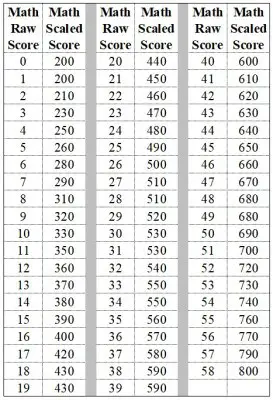
Raw Scores convert to scaled scores.
Note: when making a conversion, be sure to use the correct table, since the scale can change from test to test!
Example 1: Converting A Raw Score To A Scaled Score (SAT Math)
Let’s say that you took a practice SAT Math test and got the following results:
- 40 questions correct
- 10 questions incorrect
- 8 questions blank
Your raw score in this case is 40 (1 point for each correct question).
Using the table above, we convert the raw score of 40 to a scaled SAT Math Score of 600.
(Using the percentile table linked earlier, this score puts you in the 75th percentile, or the top 25% of test takers).
Example 2: Converting A Scaled Score To A Raw Score (SAT Math)
Let’s say that you want to get a scaled SAT Math Score of 700 or better (to qualify for an engineering scholarship).
Using the table linked above, we convert the scaled score of 700 to a raw score of 51.
This means that you must get at least 51 questions correct (out of 58 on the test) to get a raw score of 51 and a scaled score of 700. So, you can have (at most) 7 questions incorrect or blank.
Conclusion
Now you know a little more about SAT Math scores: what is average, what is exceptional, and what makes for a perfect score. You also know how to find your raw score and convert it to a scaled SAT Math score.
You can learn about some tips to help you study for the SAT Math section here.
You can learn all about the new Digital SAT here.
You can learn more about what to know for the SAT Math section here.
You can learn about the factors to consider when choosing a college here.
I hope you found this article helpful. If so, please share it with someone who can use the information.
Don’t forget to subscribe to our YouTube channel & get updates on new math videos!




